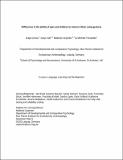Files in this item
Differences in the ability of apes and children to instruct others using gestures
Item metadata
| dc.contributor.author | Grosse, Katja | |
| dc.contributor.author | Call, Josep | |
| dc.contributor.author | Carpenter, Malinda | |
| dc.contributor.author | Tomasello, Michael | |
| dc.date.accessioned | 2015-09-24T23:11:09Z | |
| dc.date.available | 2015-09-24T23:11:09Z | |
| dc.date.issued | 2015 | |
| dc.identifier | 136173015 | |
| dc.identifier | e66c39e5-d2a2-4f1b-b6a5-ba82a9438633 | |
| dc.identifier | 84939469025 | |
| dc.identifier | 000212569800002 | |
| dc.identifier.citation | Grosse , K , Call , J , Carpenter , M & Tomasello , M 2015 , ' Differences in the ability of apes and children to instruct others using gestures ' , Language Learning and Development , vol. 11 , no. 4 , pp. 310-330 . https://doi.org/10.1080/15475441.2014.955246 | en |
| dc.identifier.other | ORCID: /0000-0002-8597-8336/work/37477961 | |
| dc.identifier.other | ORCID: /0000-0003-3983-2034/work/64698041 | |
| dc.identifier.uri | https://hdl.handle.net/10023/7537 | |
| dc.description.abstract | In all human cultures, people gesture iconically. However, the evolutionary basis of iconic gestures is unknown. In this study, chimpanzees and bonobos, and 2- and 3-year-old children, learned how to operate two apparatuses to get rewards. Then, at test, only a human adult had access to the apparatuses, and participants could instruct her about how to obtain the rewards. Children frequently produced appropriate iconic gestures, but with the exception of one human-raised chimpanzee, great apes did not gesture iconically. However, chimpanzees pointed to a reward outside the apparatus in another experimental condition, showing their motivation and ability to communicate with the human to request it. They also manipulated a duplicate apparatus in appropriate ways, though it was unclear if they did this to communicate with the human. Although great apes may have some of the prerequisite skills involved, iconic gestures come naturally to humans in a way that they do not for great apes. | |
| dc.format.extent | 609803 | |
| dc.language.iso | eng | |
| dc.relation.ispartof | Language Learning and Development | en |
| dc.subject | BF Psychology | en |
| dc.subject | NDAS | en |
| dc.subject.lcc | BF | en |
| dc.title | Differences in the ability of apes and children to instruct others using gestures | en |
| dc.type | Journal article | en |
| dc.contributor.institution | University of St Andrews. School of Psychology and Neuroscience | en |
| dc.contributor.institution | University of St Andrews. Centre for Social Learning & Cognitive Evolution | en |
| dc.identifier.doi | 10.1080/15475441.2014.955246 | |
| dc.description.status | Peer reviewed | en |
| dc.date.embargoedUntil | 2015-09-25 |
This item appears in the following Collection(s)
Items in the St Andrews Research Repository are protected by copyright, with all rights reserved, unless otherwise indicated.

